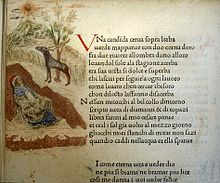
Back إل كانزونييري Arabic Сонети за живота и смъртта на мадона Лаура Bulgarian Canzoniere Breton Kanconijer BS Cançoner (Petrarca) Catalan Zpěvník (Petrarca) Czech Canzoniere Danish Canzoniere German Cancionero (Petrarca) Spanish Canzoniere French

Il Canzoniere (Italian pronunciation: [il kantsoˈnjɛːre]; English: Song Book), also known as the Rime Sparse (English: Scattered Rhymes), but originally titled Rerum vulgarium fragmenta (English: Fragments of common things, that is Fragments composed in vernacular), is a collection of poems by the Italian humanist, poet, and writer Petrarch.
Though the majority of Petrarch's output was in Latin, the Canzoniere was written in the vernacular, a language of trade, despite Petrarch's view that Italian was less adequate for expression.[1] Of its 366 poems, the vast majority are in sonnet form (317), though the sequence contains a number of canzoni (29), sestine (9), madrigals (4), and ballate (7). Its central theme is the poet's love for Laura, a woman Petrarch allegedly met on April 6, 1327, in the Church of Sainte Claire in Avignon. Though disputed, the inscription in his copy of Virgil records this information. Petrarch's meticulous dating of his manuscripts has allowed scholars to deduce that the poems were written over a period of forty years, with the earliest dating from shortly after 1327, and the latest around 1368. The transcription and ordering of the sequence itself went on until 1374, the year of the poet's death.[2] The two sections of the sequence which are divided by Laura's death have traditionally been labelled 'In vita' (In life') and 'In morte' (In death) respectively, though Petrarch made no such distinction. His work would go on to become what Spiller calls 'the single greatest influence on the love poetry of Renaissance Europe until well into the seventeenth century'.[3]

© MMXXIII Rich X Search. We shall prevail. All rights reserved. Rich X Search